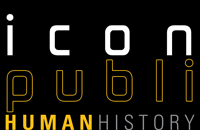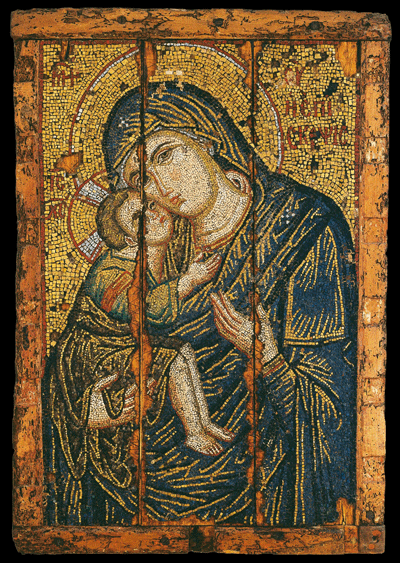
Exhibition in Athens, Greece
Refugee Treasures

Thursday 5 March 2009, by Icon Network
All the versions of this article:
- [English]
- [français]
An Exhibition arranged by the Byzantin & Christian Museum which will be inaugurated next June 29th. This exhibition has also been shown at the Castle of the Dukes of Brittany, Nantes History Museum, France, March 6th, 2009. A video of the exhibition is avalaible on this web site: Refugee-Treasures-Video.html (Greek language | English subtitles).
![]() The Virgin Episkepsis: An icon tells its story
The Virgin Episkepsis: An icon tells its story
![]() Refugees in a new land
Refugees in a new land
![]() Museum exhibit
Museum exhibit
![]() Work of art
Work of art
![]() A Symbol
A Symbol
“Refugee Treasures” has been arranged within the framework of the Icon Network Project with the support of the 2007-2013 Cultural Program of the European Commission.
The Virgin Episkepsis: An icon tells its story
One of the icons admired by visitors in the permanent display of the Byzantine and Christian Museum is the Virgin Episkepsis. It is a mosaic icon, made at the end of the 13th century. It belongs to the Refugee Heirlooms collection.
The icon comes from Triglia, in Asia Minor. Its large dimensions and its splendour reveal that it was intended for an important ecclesiastical monument.

- Virgin Episkepsis
- 14th century
From Triglix of Asie Minor
The beginning of the story
Tradition preserves different versions of how the icon was discovered. One relates that after the capture of Constantinople it was carried by the sea, along with the miraculous icon of the Virgin Pantovasilissa, to Triglia, where it was retrieved by nuns. According to another version, the icon was found by a Turk, who handed it over to the Christians.
Q: The Holy Episkepsis was brought to the Monastery of the Pateres, so I heard from my dad…
Triglia is a village in the province of Bithynia. It lies on the coast, at the entrance to the gulf of Kios. The settlement began its life in the 8th century AD, when buildings started gradually to be erected and the first Byzantine monasteries flourished in the area.
In the 19th century, Triglia reached the height of its economic and spiritual prosperity. It produced olives that were exported as far afield as Russia, and the silk cocoons from Triglia were in great demand throughout the province of Prussa. Its population was mainly Greek, spoke the Greek language and practised Christianity.
At that time, the orthodox populations of Triglia were organised in a community. Responsibility for common affairs lay with the priests and the council of elders, which was elected by the people.
School education occupied a prominent place in the affairs of the community. It emphasised the importance of the shared religion and helped to spread the Greek language.
Q: Chrysostomos of Smyrna, who came from Triglia, built us a fine school. Not even Constantinople had a school like it! I still remember him carrying stones so that it could be built!
Q: The Bishop came at Epiphany for the children’s examinations. I’m going to Triglia, he would say, to get my fill of letters. And our village produced priests, bishops and teachers.
Icons seem to have been an inseparable part of daily life. People kept them, even in their houses, venerated them, and in times of danger called on them for protection. So it was in 1922, when 1,000,000 refugees came to Greece after the Asia Minor disaster. Amongst their few personal belongings, they took with them icons and vessels from their homes and churches.
Refugees in a new land
Q: In 1922, when the Asia Minor front broke and the Greek army retreated in disorder, the president of the community and the community council unanimously sent an urgent letter to my father, Philippos Kavounidis, who was a ship owner based in Constantinople, asking him to make every effort to save them. My father did in fact take action: he sent his own ships and chartered others and saved all the inhabitants of Triglia and the surrounding area. He himself travelled on the last rescue ship, the “Bithynia”. He disembarked at Triglia and, accompanied by a band of armed sailors and fellow villagers, he collected the holy vessels from all the churches and monasteries, including the two most sacred icons of the village, the mosaic icon of the Episkepsis and the miraculous icon of the Virgin Pantovasilissa.
The refugees from Triglia were taken to Tenedos, the islet of Kalolimnos, Raidestos, Thessaloniki and Piraeus.
Q: We fled like birds from the trees…
The winter of 1922 found the villagers of Triglia scattered in various parts of Greece. They lived by whatever work they could find and on meagre assistance from the State.
The Greek state founded villages to deal with the severe refugee housing problem. In 1923, the refugees from Triglia were given land at Raphina in Attica and Souphlari in Chalkidiki, where the village of Nea Triglia was created.
Q: They made two Triglias. They made the Pantovasilissa here in Nea Triglia, and they made her in Raphina, too.
The refugees were gradually adjusted to their new homeland. The ecclesiastical heirlooms were a common reference point for them, around which they rebuilt their lives.
Museum exhibit
The retrieval and safekeeping of holy objects brought by the refugees, soon assumed an official character, as it was taken over by the State. In the years that followed, various committees were formed for this purpose, and as early as 1922, ecclesiastical heirlooms from different parts of Asia Minor and East Thrace were handed in to the Byzantine Museum for temporary safekeeping.
The handing in of the icon of the Virgin Episkepsis to the Byzantine and Christian Museum in 1925, together with the icon of the Virgin Pantovasilissa, led to other sacred heirlooms remaining in the museum, where they later formed the Refugee Heirlooms Collection. The then director of the museum, Georgios Sotiriou recognised the value of the Episkepsis and at once submitted a request that the icon should remain permanently in the Byzantine Museum.
From this time on, the Episkepsis was to be displayed in the Athens Academy, now as a museum exhibit.
Work of art
At the time that the icon was made, Triglia was a patriarchal exarchate of Constantinople. In the 13th century, the Byzantine Empire was greatly weakened. Nevertheless, it developed outstanding artistic activity.
It is not known who made the Episkepsis. He was probably from Constantinople. This theory is also supported by the oral tradition.
The Virgin Episkepsis was made in the last golden age of Byzantine art. Portable mosaic icons were precious, greatly coveted artefacts of this era.
Today, fewer than 50 mosaic icons survive, most of them dating from the 13th and 14th century. Of these, about 37 are miniatures.
Small mosaic icons were luxury items created mainly by the imperial workshops of Constantinople, and were associated with the higher echelons of Byzantine society.
No more than a dozen large or medium-sized mosaic icons are preserved. A few choice items survive from Constantinople.
Because of the way they are made, mosaic icons do not endure over time. The tesserae were set in beeswax or ceromastic on a piece of flat wood. They were made of glass paste, enamel, coloured marble, and semiprecious or precious stones. Gilded bronze or silver tesserae were used for the background.
The tesserae of the Episkepsis are made of glass paste. Unfortunately, a large number of them has been lost, especially at the points where the three pieces of wood are joined together. The frame of the icon probably had silver or silver-gilt sheathing that is also lost, along with the small icons or ornaments on its vertical sides. The notch at the top of the icon is evidence that it was carried in procession. It was probably also a despotic icon, placed low down on the iconostasis so that the congregation could venerate it.
The epithet Episkepsis (‘Shelter’) alludes to the miraculous intervention of the Virgin in times of need. She is the “shelter of the sick”: the tender, loving mother who protects Christians beneath her shelter.
A Symbol
As with the heirlooms of many refugee communities, the people of Triglia asked the Byzantine and Christian Museum to return the two icons from their village in 1954. The miraculous icon of the Virgin Pantovasilissa was given to the church of this name in Raphina. The icon of the Episkepsis remained in the museum after a decision taken by the Greek state.
The Episkepsis is one of the most important works in the Byzantine and Christian Museum.
Its artistic and historical value, as well as its rarity, mean that it is rarely taken outside the museum. So far, it has left the museum on only three occasions.1
Ιn 2002, the parish of the church of the Koimesis at Raphina submitted a request to the Byzantine and Christian Museum that the Episkepsis should be loaned and made available for veneration for a period of ten days. Instead, an exact copy of the icon was made and given to the community for this purpose.
Today, the great challenge to the personnel of the Byzantine Museum is to preserve not only the artefact itself, but more importantly, the links between the icon and the people who created and shared in its history.